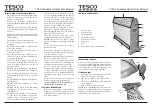
Model LG Pool and Spa Heater
Page 19
7.2 Start-Up
CAUTION
Do not use this heater if any part has been
under water. Immediately call a qualified
service technician to inspect the heater and
replace any part of the control system and any
gas control which has been under water.
CAUTION
Should overheating occur or the gas supply fail
to shut off, turn off the manual gas control
valve to the heater.
CAUTION
Do not attempt repairs on the gas controls or
appliance. Tampering is dangerous and voids
all warranties.
CAUTION
Keep all objects off the top of the heater.
Blocking air flow could damage the heater, and
may void the warranty.
WARNING
Vent pipes, draft hoods, and heater tops get
hot! These surfaces can cause serious burns.
Do not touch these surfaces while the heater is
in operation. Adding a vent cap reduces the
temperature on the top.
WARNING
For your safety, when starting the heater, keep
your head and face well away from the lower
firebox opening to prevent any risk of personal
injury.
Be sure that there is water in the pool and that
the surface level is above the skimmer or other inlet of
the pool’s filter system.
Confirm that pool water is flowing normally
through the pool system and equipment. With any
new pool or spa installation, operate the filter pump
with the heater off long enough to completely clean
the water. This will remove any installation residue
from the water. Clean the filter at the end of this
operation before starting the heater. Start the heater
in accordance with the Operating Instructions section
of this manual, with particular attention to the lighting
and shutdown instructions and temperature control
operation.
When raising the temperature of a cold pool,
remove all time clock settings. This lets the filter
system and heater operate continuously until the water
reaches the temperature setting on the temperature
control. When that happens, the heater will automati-
cally shut off, but the filter pump will keep running.
When the heater starts, immediately feel the
outlet header of the heater to confirm that there is
adequate water flow. The header should not be hot.
Normally, water temperature will rise only a few
degrees as it passes through the heater, and a “hot”
header or pipe indicates low water flow.
















































